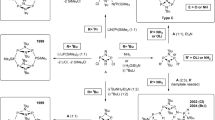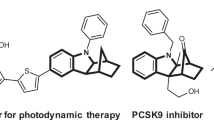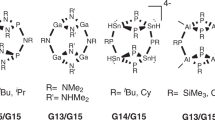Abstract
Since the discovery of crown ethers, macrocycles have been recognized as powerful platforms for supramolecular chemistry. Although their numbers and variations are now legion, macrocycles that are simple to make using high-yielding reactions in one pot and on the multigram scale are rare. Here we present such a discovery obtained during the creation of a C5-symmetric cyanostilbene ‘campestarene’ macrocycle, cyanostar, that employs Knoevenagel condensations in the preparation of its cyanostilbene repeat unit. In the solid state, cyanostars form π-stacked dimers constituted of chiral P and M enantiomers. The electropositive central cavity stabilizes anions with CH hydrogen-bonding units that are activated by electron-withdrawing cyano groups. In solution, the cyanostar shows high-affinity binding as 2:1 sandwich complexes, log β2 ≈ 12 and ΔG ≈ −70 kJ mol−1, of large anions (BF4−, ClO4− and PF6−) usually considered weakly coordinating. The cyanostar's size preference allowed formation of an unprecedented [3]rotaxane templated around a dialkylphosphate.
This is a preview of subscription content, access via your institution
Access options
Subscribe to this journal
Receive 12 print issues and online access
$259.00 per year
only $21.58 per issue
Buy this article
- Purchase on Springer Link
- Instant access to full article PDF
Prices may be subject to local taxes which are calculated during checkout





Similar content being viewed by others

References
Pedersen, C. J. Cyclic polyethers and their complexes with metal salts. J. Am. Chem. Soc. 89, 2495–2496 (1967).
de Silva, A. P. et al. Signaling recognition events with fluorescent sensors and switches. Chem. Rev. 97, 1515–1566 (1997).
Cram, D. J. & Sogah, G. D. Y. Chiral crown complexes catalyse Michael addition reactions to give adducts in high optical yields. J. Chem. Soc. Chem. Commun. 625–628 (1981).
Ma, D. et al. Acyclic cucurbit[n]uril molecular containers enhance the solubility and bioactivity of poorly soluble pharmaceuticals. Nature Chem. 4, 503–510 (2012).
Stoddart, J. F. The chemistry of the mechanical bond. Chem. Soc. Rev. 38, 1802–1820 (2009).
Kay, E. R., Leigh, D. A. & Zerbetto, F. Synthetic molecular motors and mechanical machines. Angew. Chem. Int. Ed. 46, 72–191 (2007).
Höger, S. Shape-persistent phenylene–acetylene macrocycles: large rings–low yield? Angew. Chem. Int. Ed. 44, 3806–3808 (2005).
Busch, D. H. The significance of complexes of macrocyclic ligands and their synthesis by ligand reactions. Rec. Chem. Progr. 25, 107–126 (1964).
Ogoshi, T., Kanai, S., Fujinami, S., Yamagishi, T. & Nakamoto, Y. para-Bridged symmetrical pillar[5]arenes: their Lewis acid catalyzed synthesis and host–guest property. J. Am. Chem. Soc. 130, 5022–5023 (2008).
Yuan, L. H. et al. Highly efficient, one-step macrocyclizations assisted by the folding and preorganization of precursor oligomers. J. Am. Chem. Soc. 126, 11120–11121 (2004).
Zhang, W. & Moore, J. S. Arylene ethynylene macrocycles prepared by precipitation-driven alkyne metathesis. J. Am. Chem. Soc., 126, 12796 (2004).
Hua, Y. & Flood, A. H. Click chemistry generates privileged CH hydrogen-bonding triazoles: the latest addition to anion supramolecular chemistry. Chem. Soc. Rev. 39, 1262–1271 (2010).
Bryantsev, V. S. & Hay, B. P. Are C–H groups significant hydrogen bonding sites in anion receptors? Benzene complexes with Cl−, NO3−, and ClO4−. J. Am. Chem. Soc. 127, 8282–8283 (2005).
Li, Y. & Flood, A. H. Pure C–H hydrogen bonding to chloride ions: a preorganized and rigid macrocyclic receptor. Angew. Chem. Int. Ed. 47, 2649–2652 (2008).
Sessler, J. L. et al. A pyrrolyl-based triazolophane: a macrocyclic receptor with CH and NH donor groups that exhibits a preference for pyrophosphate anions. J. Am. Chem. Soc. 132, 14058–14060 (2010).
Tinant, B. et al. Structural study of stilbenes. 2. Crystal-structure redetermination of trans-4′-dimethylamino-4-nitro-α-cyanostilbene C17H15N3O2 . Bull. Soc. Chim. Belg. 92, 403–404 (1983).
Yu, G. & Heeger, A. J. Charge separation and photovoltaic conversion in polymer composites with internal donor–acceptor heterojunctions. J. Appl. Phys. 78, 4510–4515 (1995).
An, B-K., Kwon, S-K., Jung, S-D. & Park, S. Y. Enhanced emission and its switching in fluorescent organic nanoparticles. J. Am. Chem. Soc. 124, 14410–14415 (2002).
Rosenthal, M. R. The myth of the non-coordinating anion. J. Chem. Educ. 50, 331–335 (1973).
Yuan, L. et al. Highly efficient, one-step macrocyclizations assisted by the folding and preorganization of precursor oligomers. J. Am. Chem. Soc. 126, 11120–11121 (2004).
Qin, B. et al. Crystallographic evidence of an unusual, pentagon-shaped folding pattern in a circular aromatic pentamer. Org. Lett. 10, 5127–5130 (2008).
Guieu, S., Crane, A. K. & MacLachlan, M. J. Campestarenes: novel shape-persistent Schiff base macrocycles. Chem. Commun. 47, 1169–1171 (2011).
Zhang, J., Pesak, D. J., Ludwick, J. L. & Moore, J. S. Geometrically-controlled and site-specifically-functionalized phenylacetylene macrocycles. J. Am. Chem. Soc. 116, 4227–4239 (1994).
Du, Z. et al. BOP-mediated one-pot synthesis of C5-symmetric macrocyclic pyridone pentamers. Chem. Commun. 47, 12488–12490 (2011).
Qin, B. et al. Persistently folded circular aromatic amide pentamers containing modularly tunable cation-binding cavities with high ion selectivity. J. Am. Chem. Soc. 132, 9564–9566 (2010).
Ren, C. et al. Crystallographic realization of the mathematically predicted densest all-pentagon packing lattice by C5-symmetric ‘sticky’ fluoropentamers. Angew. Chem. Int. Ed. 50, 10612–10615 (2011).
Ren, C., Xu, S., Xu, J., Chen, H. & Zeng, H. Planar macrocyclic fluoropentamers as supramolecular organogelators. Org. Lett. 13, 3840–3843 (2011).
Tahara, K., Balandina, T., Furukawa, S., De Feyter, S. & Tobe, Y. Molecular pentagonal tiling: self-assemblies of pentagonal-shaped macrocycles at liquid/solid interfaces. CrystEngComm 13, 5551–5558 (2011).
Alcalde, E., Ayala, C., Dinarès, I. & Mesquida, N. Polynucleating open-chain systems with imidazole and proton-ionizable 1,2,4-triazole structural motifs. J. Org. Chem. 66, 2291–2295 (2001).
Dürer, A. Treatise on Mensuration with the Compass and Ruler in Lines, Planes, and Whole Bodies (Dürer, 1525).
Caspar, D. L. D. & Fontano, E. Five-fold symmetry in crystalline quasicrystal lattices. Proc. Natl Acad. Sci. USA 93, 14271–14278 (1996).
Bandera, D., Baldridge, K. K., Linden, A., Dorta, R. & Siegel, J. S. Stereoselective coordination of C5-symmetric corannulene derivatives with an enantiomerically pure [RhI(nbd*)] metal complex. Angew. Chem. Int. Ed. 50, 865–867 (2011).
Hanson, J. C. & Nordman, C. E. The crystal and molecular structure of corannulene, C20H10 . Acta Cryst. B 32, 1147–1153 (1976).
Li, Y., Pink, M., Karty, J. A. & Flood, A. H. Dipole-promoted and size-dependent cooperativity between pyridyl-containing triazolophanes and halides leads to persistent sandwich complexes with iodide. J. Am. Chem. Soc. 130, 17293–17295 (2008).
Szumna, A. Inherently chiral concave molecules – from synthesis to applications. Chem. Soc. Rev. 39, 4274–4285 (2010).
Brak, K. & Jacobsen, E. N. Asymmetric ion-pairing catalysis. Angew. Chem. Int. Ed. 52, 534–561 (2013).
Greer, M. A., Goodman, G., Pleus, R. C. & Greer, S. E. Health effects assessment for environmental perchlorate contamination: the dose response for inhibition of thyroidal radioiodine uptake in humans. Environ. Health Persp. 110, 927–937 (2002).
Etacheri, V., Marom, R., Elazari, R., Salitra, G. & Aurbach, D. Challenges in the development of advanced Li-ion batteries: a review. Energy Environ. Sci. 4, 3243–3262 (2011).
Hristova, Y. R., Smulders, M. M. J., Clegg, J. K., Breiner, B. & Nitschke, J. R. Selective anion binding by a ‘chameleon’ capsule with a dynamically reconfigurable exterior. Chem. Sci. 2, 638–641 (2011).
Hayashida, O., Shivanyuk, A. & Rebek, J. Jr Molecular encapsulation of anions in a neutral receptor. Angew. Chem. Int. Ed. 41, 3423–3426 (2002).
Roobottom, H. K., Jenkins, H. D. B., Passmore, J. & Glasser, L. Thermochemical radii of complex ions. J. Chem. Educ. 76, 1570–1573 (1999).
Gibb, C. L. D. & Gibb, B. C. Anion binding to hydrophobic concavity is central to the salting-in effects of Hofmeister chaotropes. J. Am. Chem. Soc. 133, 7344–7347 (2011).
Hübner, G. M., Gläser, J., Seel, C. & Vögtle, F. High-yielding rotaxane synthesis with an anion template. Angew. Chem. Int. Ed. 38, 383–386 (1999).
Keaveney, C. M. & Leigh, D. A. Shuttling through anion recognition. Angew. Chem. Int. Ed. 43, 1222–1224 (2004).
Brouwer, A. M. et al. Photoinduction of fast, reversible translational motion in a hydrogen-bonded molecular shuttle. Science 291, 2124–2128 (2001).
Ghosh, P., Mermagen, O. & Schalley, C. A. Novel template effect for the preparation of [2]rotaxanes with functionalized centre pieces. Chem. Commun. 2628–2629 (2002).
Lee, C. F. et al. Hybrid organic–inorganic rotaxanes and molecular shuttles. Nature 458, 314–318 (2009).
Wisner, J. A., Beer, P. D., Drew, M. G. B. & Sambrook, M. R. Anion-templated rotaxane formation. J. Am. Chem. Soc. 124, 12469–12476 (2002)
Ashton, P. R. et al. Self-assembling [2]- and [3]rotaxanes from secondary dialkylammonium salts and crown ethers. Chem. Eur. J. 2, 729–736 (1996).
Katayev, E. A., Ustynyuk, Y. A. & Sessler, J. L. Receptors for tetrahedral oxyanions. Coord. Chem. Rev. 250, 3004–3037 (2006).
Craig, M. R., Claridge, T. D. W., Hutchings, M. G. & Anderson, H. L. Synthesis of a cyclodextrin azo dye [3]rotaxane as a single isomer. Chem. Commun. 1537–1538 (1999).
Talotta, C., Gaeta, C., Pierro, T. & Neri, P. Sequence stereoisomerism in calixarene-based pseudo[3]rotaxanes. Org. Lett. 13, 2098–2101 (2011).
Vander Griend, D. A., Bediako, D. K., DeVries, M. J., DeJong, N. A. & Heeringa, L. P. Detailed spectroscopic, thermodynamic, and kinetic characterization of nickel(II) complexes with 2,2′-bipyridine and 1,10-phenanthroline attained via equilibrium-restricted factor analysis. Inorg. Chem. 47, 656–662 (2008).
Acknowledgements
We acknowledge the National Science Foundation (NSF/CHE-0844441) for financial support. S.L. thanks the Raymond Siedle Fellowship in Materials Chemistry. Crystal data were recorded using ChemMatCARS Sector 15, principally supported by the NSF and Department of Energy under grant number NSF/CHE-0822838. Use of the Advanced Photon Source was supported by the US Department of Energy, Office of Science, Office of Basic Energy Sciences, under Contract No. DE-AC02-06CH11357.
Author information
Authors and Affiliations
Contributions
S.L. conceived this project, and designed and conducted the syntheses and experiments. C-H.C. conducted the crystallographic study. S.L. and A.H.F. contributed to the data analysis and co-wrote the paper.
Corresponding author
Ethics declarations
Competing interests
A provisional US patent application has been filed.
Supplementary information
Supplementary information
Supplementary information (PDF 6289 kb)
Supplementary information
Crystallographic data for compound CS. (CIF 73 kb)
Supplementary information
Crystallographic data for compound 3TBA. (CIF 161 kb)
Rights and permissions
About this article
Cite this article
Lee, S., Chen, CH. & Flood, A. A pentagonal cyanostar macrocycle with cyanostilbene CH donors binds anions and forms dialkylphosphate [3]rotaxanes. Nature Chem 5, 704–710 (2013). https://doi.org/10.1038/nchem.1668
Received:
Accepted:
Published:
Issue Date:
DOI: https://doi.org/10.1038/nchem.1668
This article is cited by
-
Aromatic pentaamide macrocycles bind anions with high affinity for transport across biomembranes
Nature Chemistry (2023)
-
Systematic construction of progressively larger capsules from a fivefold linking pyrrole-based subcomponent
Nature Synthesis (2023)
-
A contorted nanographene shelter
Nature Communications (2021)
-
Radical-pairing-induced molecular assembly and motion
Nature Reviews Chemistry (2021)
-
Highly efficient synthesis of non-planar macrocycles possessing intriguing self-assembling behaviors and ethene/ethyne capture properties
Nature Communications (2020)


